Exhibit Reviews / Comptes rendus d'expositions
Aluminum by Design:
From Jewellery to Jets
1 In recent years there has been a noticeable increase in interest among museums in the subject of materials and materials science. This trend has manifested itself in exhibits exploring different and new facets of the field. In contrast to our traditional attraction with artifacts constructed of, or incorporating, precious or semiprecious materials, these exhibits are now taking a more elemental or global approach to the way that materials have influenced society and vice versa. One indication of this trend is that three national museums have addressed the subject of materials in recent exhibits. The Smithsonian's National Museum of American History, in Washington, D.C., installed the exhibit Material World, while The Science Museum in London has created its Materials Gallery. Both exhibits explore the history of materials and the fascinating relationship between materials, their nature, and use. Following suit, in 1999 the National Museum of Science and Technology in Ottawa, now the Canada Science and Technology Museum, installed a large centrally located temporary exhibit on the subject, aptly entitled Materials.
2 On the one hand, these exhibits reflect a growing sophistication in our appreciation and study of material history and the interaction between the materials, their inherent characteristics, production techniques, and use. Advancing beyond the traditional Stone, Bronze and Iron Age classifications of classical archaeology, our present interest in materials allows a fundamental examination of objects beginning with the far from accidental circumstances that lead to their use in specific applications. The organization and study of objects based on material of construction allows us to approach them from a different perspective and thus see them in a different light. With a growing variety of materials at our disposal, increasingly our choice of materials are social constructs, reflecting design, economic and cultural decisions. All one has to do is to consider why melamine may be wood grained to appreciate the cultural and economic dynamic related to some new materials.
3 Museums mirror a broader public interest in the subject. Publications, such as Ivan Amato's Stuff: The Materials the World is Made of (Avon Books, 1997), Philip Ball's Made To Measure: New Materials for the Twenty-First Century (Princeton, 1997), or Stephen Sass's The Substance of Civilization (Arcade, 1998) are a few examples of publications written recently by materials scientists for a general public. While our awareness of the importance of materials is not new, over the last one hundred and fifty years the number of raw materials available to humanity has increased substantially due in great part to pure and applied science. The remarkable impact of synthetic materials ranging from plastics to silicon chips upon contemporary society are evident everywhere. Whether one speaks of materials or the food chain, our ability to design materials now appears limitless. How and why we use these materials is the stuff of history.
4 Which brings us to the topic of this review, a travelling exhibit at the Montreal Museum of Fine Arts entitled Aluminum by Design: From Jewellery to Jets, an interesting and informative project organized by the Carnegie Museum of Art and sponsored by the Alcoa Foundation. The exhibit, which is accompanied by an excellent catalogue, fits well into the traditional mould of an art gallery exhibit with its strong celebratory mood. It is a celebration of aluminum and its unique qualities, a retrospective look at a ubiquitous material and its transition from a semiprecious metal to the stuff of disposable soft drink cans. Visitors to the exhibit experience a well organized presentation featuring, as noted in the press releases, approximately one hundred and eighty artifacts drawn from institutions and collections in Europe and North America. The objects presented run from the stunningly beautiful, such as the full scale replica of Otto Werner's facade for the Zeit (1902), and the 1932 aluminum violin (Fig. 1) to the far more mundane late twentieth century aluminum alloy tennis rackets.
5 While the promotional material associated with the exhibit describes it as "groundbreaking," this may be something of an exaggeration. As noted above, it should be viewed as part of a broader trend of contemporary society's and museums' interest in materials science. This does not detract from its value, because it is an important exhibit that provides an informative overview of how aluminum has been used by architects, designers, engineers, and artists to fabricate objects of beauty, functionality and whimsy. However, in underscoring the importance of the subject and relevance of the material to modern society, the exhibit makes some sweeping generalizations that belie reality. For example, early on, we are told that "For the last one hundred and fifty years aluminum has been a material that embodies the cultural and design aspirations of the moment." This is a highly questionable comment given the remarkable role of both steel and plastics in shaping the products of modern consumer society. Qualifying the same statement would not have detracted from the fact that aluminum is a pervasive material that is consumed today in larger quantities than any other metal, apart from steel.
6 The exhibit is organized around four main thematic sections that also correspond to a chronological framework that traces the use of aluminum from the decades following the production of the first minuscule laboratory samples in the 1850s up to the present. The first section, entitled "Inventing Aluminum," discusses the transition of the metal from a semiprecious substance to a more common, mass produced material. The cost of extracting aluminum prior to the invention of the Hall-Héroult process in the 1880s resulted in aluminum's use in luxury goods. A variety of exotic objects illustrate this brief but illustrious period for the metal, including two pair of opera glasses dating from ca 1870 (Fig. 2).
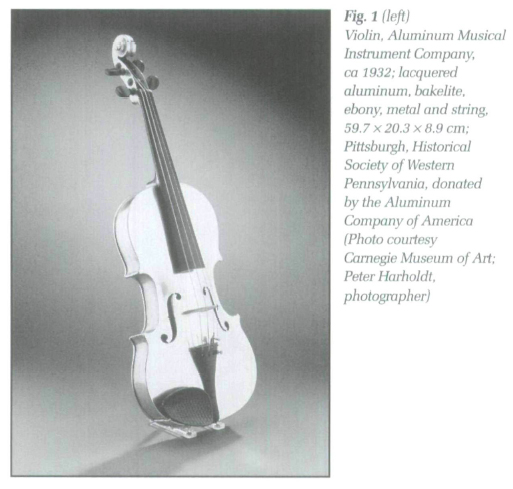 Display large image of Figure 1
Display large image of Figure 17 As is so often the case in the exhibit, there is a double meaning to the title as the visitor is not only initiated to the idea of the material being discovered in the mid-nineteenth century, but also to the ways that manufacturers and others sought new ways to exploit its qualities once it was commercially viable. These characteristics of light weight, ductility, resistence to corrosion, and conduct ability, to name but a few, opened the door to many different applications. As explained in the text, while "science and technology made this remarkable new material available, imagination and innovation were needed to develop its potential." Its potential use in architectural applications and detail as well as in mass-produced products, such as combs, was quickly exploited. The comparison of two biscuit boxes, one in pewter and another in aluminum underscores early attempts to seek markets for the product by using the material to replace more traditional and expensive materials.
8 The second section, dealing with the inter-war period, presents aluminum as a vehicle of the modern movement and is aptly entitled "The Modernist Ideal." In an attempt to establish a strong social context for this section, the visitor encounters a text of sweeping proportions.
9 In this crucible of social, political and economic change, aluminum came of age in the hands of a new set of industrial designers who proceeded to explore new applications for the magic metal. With increased availability following the First World War, aluminum was more commonplace while still retaining an element of novelty. Transportation was a major beneficiary based on the variety of artifacts and works presented in this section. The centre piece of the section is an aluminum clad motorcycle that symbolizes the malleability of the metal with its luminescent qualities. Streamlining and an impression of speed typifies it and many of the objects contained or illustrated in this section. While industrial design is represented in transportation and domestic artifacts, the use of aluminum and its alloys in the decorative arts and architecture is also well represented. Aluminum had reached a certain maturity by this period as marked by designers' willingness to accentuate its own surface qualities rather than imitating those of other traditional materials. One simple element, Paul Cret's interior decoration for one of the Sante Fe Railroad's aluminum clad streamlined dining cars acts as an interesting link between the decorative and industrial arts (Fig. 3). It helps in its small way to drive home one of the underlying themes — design was not introduced gratuitously, but with strong economic reasons in mind. As we are reminded in the exhibit text, "manufacturers realized that good design gave their products a definite advantage in the consumer market."
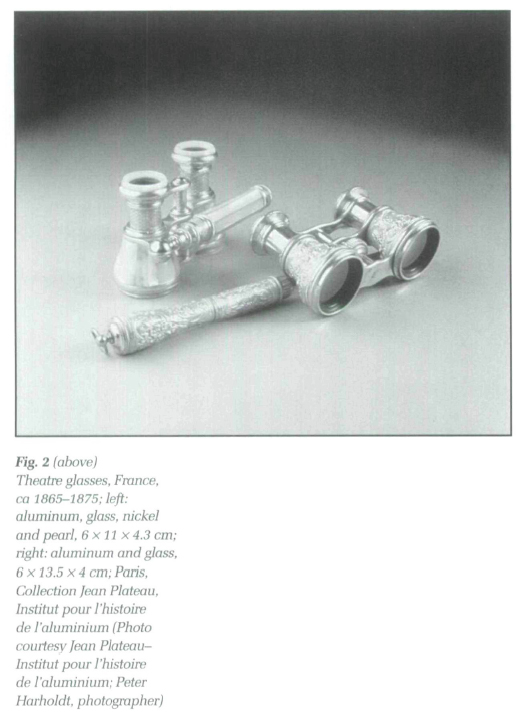 Display large image of Figure 2
Display large image of Figure 2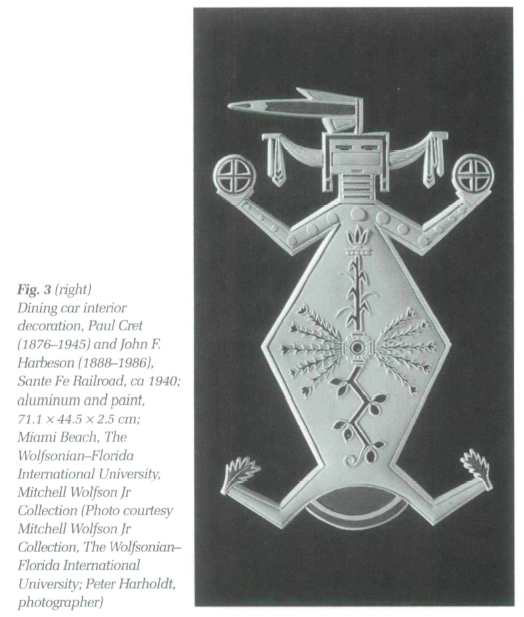 Display large image of Figure 3
Display large image of Figure 310 This is very much the theme that continues into the third section of the exhibit, "Competition and Conflict." The Second World War witnessed another substantial boost in aluminum production and use. The aviation industry used the metal extensively, solidifying its image as a modern, high-tech material. The postwar period was marked by renewed attempts by the aluminum industry to market its product through the use of effective marketing and design. Designers again came to the fore to produce innovative designs intended to entice potential buyers. This section, while featuring an array of dishes and utensils designed by Russell Wright for middle class entertaining, was somewhat weaker and less well represented than one might have expected. Given the wide range of pots, pans and assorted other everyday objects produced in this period, the selection was both rarefied and sparse.
11 Undoubtedly, the one portion of the exhibit where I experienced the most difficulty was the fourth and final section, entitled "Crossing Boundaries: Furniture Fashion and Fun." While the first three sections of the exhibit were bent upon demonstrating aluminum's qualities as a material that both reflected and shaped social trends, the last takes a far more light-hearted, if not whimsical approach. The use of aluminum in designer fashion, both in fabrics and more metallic designs such as Paco Rabanne's, was one application that left me wondering about its relative importance. Similarly the preponderance of chairs, such as Ron Arad's Un-cut chair (Fig. 4), while interesting in demonstrating the variety of applications was somewhat repetitive to anyone but a specialist in that field.
12 If the purpose of this last section was to demonstrate the versatility of aluminum and the remarkable ingenuity of designers to manipulate a material to meet their needs, then a greater diversity of objects and applications would have had considerably more impact. The use of two Aibo robotic dogs to represent aluminum's use in the robotics field, while interesting, is less representative of robotics than of consumer electronics (Fig. 5). In fact, the Audi automobile frame located near the entrance of the exhibit would have been better located in this section simply to have reinforced the new markets and applications that continue to open up for a material that has actually been around not much longer than mass produced steel. Indeed, I was looking forward to seeing the jet mentioned in the title, even a portion of one. Marc Newson's Lockheed Lounge, a chaise lounge used in much of the promotional material and gracing the cover of the exhibit catalogue, is the closest one will come to a jet in the exhibit.
13 The one major criticism arising out of my experience of this exhibit was that while design figures prominently in the title and the selection of objects, it was never really explained. By this I mean that the exhibit presents such superb opportunities to illustrate process. Process both in terms of developing the raw material and process in creating works of exceptional beauty or utility. This may have opened some doors to subjects that are best discussed elsewhere, such as the environmental cost of aluminum production. However, the idea of aluminum's enormous versatility and ability to be cast, moulded, formed, extruded and so on, was never really pursued in the exhibit. Doing so would have made a good exhibit just that much better.
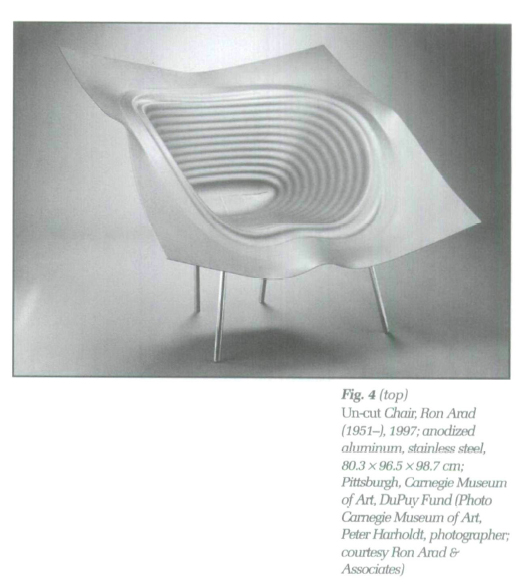 Display large image of Figure 4
Display large image of Figure 4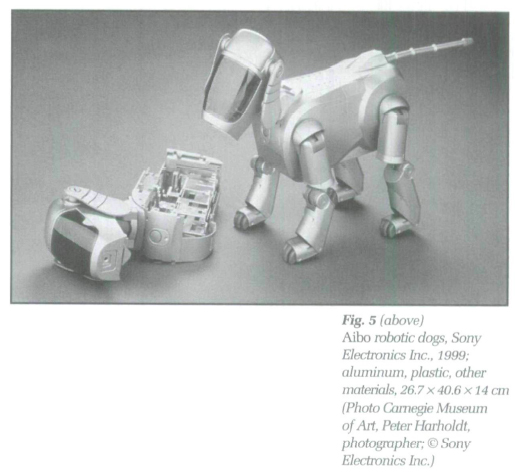 Display large image of Figure 5
Display large image of Figure 5